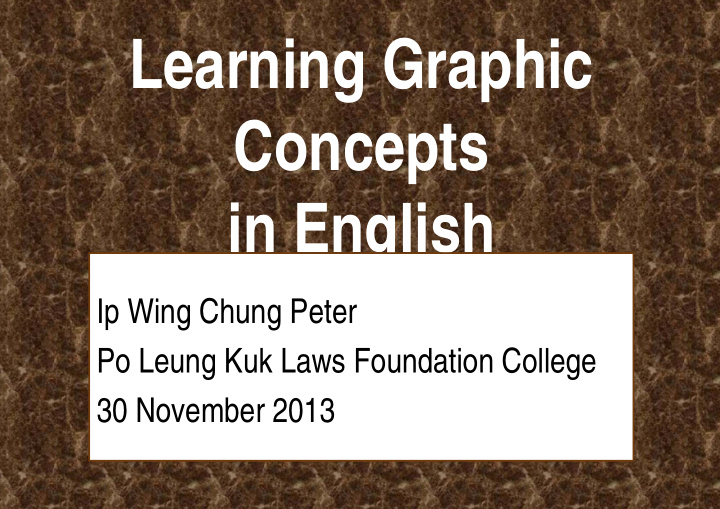



Learning Graphic Concepts in English Ip Wing Chung Peter Po Leung Kuk Laws Foundation College 30 November 2013
Background of my school • The English standard of most of our students is average. • The students prefer using Cantonese rather than English for learning. • They usually resist learning IT concepts but are very interested in learning practical IT skills.
What I will be talking about The class is S4. My topic today is Graphics. This topic is concerned with pure conceptual knowledge with no or very few practical IT skills. It includes: o differences between bitmaps and vector graphics o technical terms such as pixel, colour depth, and resolution o mathematical operations such as the calculation of resolution and file size.
Before the course I had difficulty in using English only. I mainly used the PowerPoint provided by the publisher and lectured for the whole lesson. Students highlighted key sentences in their textbooks. Students did the textbook exercises after each sub-topic (about 10 minutes in a 60-minute lesson). Students treated me as the Yahoo! dictionary to translate the words in the textbook or PowerPoint from English to Chinese. Students were very bored and were often sleepy when dealing with conceptual knowledge. The learning environment in the classroom was very quiet with little discussion
After the course Less language, more visuals (static and moving) I use simple English for the whole lesson and try to speak clearly and at a good pace. I design my PowerPoint presentations with a few simple English words and with more visual pictures or videos to introduce the topics before the students open their textbooks.
http://www.youtube.com/watch?v=Cc0F6jpOns0
After the course Present the knowledge in the right sequence I give an overview of the lesson. I move from everyday terms to technical terms and this is designed in my PowerPoint presentations and the worksheets.
After the course Stay “slightly ahead” of the students’ knowledge I break down the knowledge into manageable sub-topics. I offer various but appropriate kinds of learning activities (worksheets, hands-on tasks or open discussion) to build up the knowledge. Example: How to calculate the image file size: • no. of students in a hall Everyday • no. of uniforms in a hall • no. of bits in an image file Technical • no. of MB of a file
After the course Use multiple ways of making meaning The students are engaged in the learning through discussing what knowledge there is behind a visual or video—it is not just chalk and talk I create more worksheets for them to consolidate what they have learn from the lesson—at least half of the lesson time is allocated so the students “manipulate” the knowledge. I create some tasks for the students to work with their computers to apply and consolidate the knowledge being learnt.
After the course Provide cycles of learning so that the students spiral up to higher evels of knowledge I facilitate the continuous building up of the knowledge by making sure the students re-apply their prior knowledge in developing the new knowledge. I make the students active in the classroom not by simply doing things with their hands with concrete things but also “manipulating” abstract concepts on their own. The class reviews what they have learnt.
After the course Provide cycles of learning so that the students spiral up to higher levels of 1 2 knowledge . The students learn basic computer graphic concepts through my PowerPoint presentations. 2. They work on computer graphic concepts and start to do calculations on their worksheets. 3. They develop further the computer graphic concepts by calculating the image data with the computer, calculating the compression ratio and also practising simple, hands-on image editing skills.
What are the results? Students are more willing to interact and to discuss with me the conten and knowledge behind the pictures or videos during the introduction. Students are physically and mentally more engaged as they need to do the worksheets or tasks after each short mini-cycle of teaching and learning. Students think that the lessons are slightly challenging but they are not lost. In fact, they are forever engaged and willing to follow my teaching Students know what kind of questions they can ask. My questions have changed, too, so now I ask questions that the students know they can answer because the questions are asking about knowledge that is “slightly in front” of their current knowledge.
Recommend
More recommend